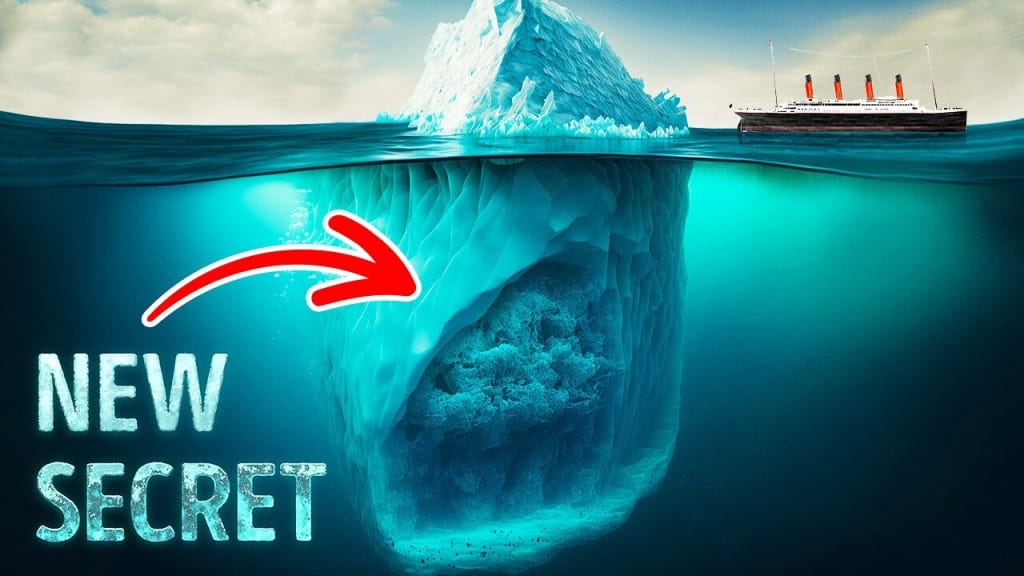"Unveiling the Secrets of the Titanic: From Iceberg Encounters to Mysterious Curses"
"Exploring the Untold Stories Behind the Tragic Sinking of the Titanic"

A beam of electric light pierces through the darkness, illuminating the calm waters of the Atlantic Ocean. The majestic Titanic glides silently through the waves, its passengers peacefully asleep. Suddenly, a monstrous white shape appears within the light beam—a faithful iceberg about to rend the side of the legendary ship. This event took place on April 14, 1912, merely two days before a photograph of an unusually elliptical iceberg was captured. Recent research, utilizing computer modeling and data from 1912, has shed light on the iceberg's origins, tracing it back to a small cluster of glaciers in Southwest Greenland. Calculating the iceberg's journey reveals that it was en route from Greenland to an area further south of Cornwall. Had the Titanic encountered the iceberg just two days later, it would have moved far away from their meeting point.
Initially weighing a staggering 75 million tons, the most infamous iceberg in the world gradually melted over time. By the time of the collision, its weight had diminished to 1.5 million tons. While it had likely been melting for months, the iceberg remained a formidable entity. Some speculate that the sinking of the Titanic was influenced by a rare lunar event—a supermoon. This lunar occurrence, which hadn't happened for 1,400 years, potentially caused an unusually high tide, accelerating the iceberg's movement away from the glacier.
Remarkably, specific bacteria present in the ocean slowly consume the remains of the Titanic, aided by factors such as salt corrosion, ocean currents, and freezing temperatures. This rust-eating microorganism may eventually consume the entire wreckage.
Amidst the tragedy, stories of love emerged on the Titanic. Thirteen couples embarked on the ship as part of their honeymoon, seeking a romantic journey. One couple, in particular, from Macy's department store in New York, faced a heart-wrenching decision. As the Titanic rapidly sank, the woman refused to enter a lifeboat without her husband. However, he insisted that she leave first, prioritizing women and children. In a selfless act, the wife gave her coat to her maid, ensuring her warmth in the lifeboat, while she remained by her husband's side until the end.
Interestingly, a novella titled "Futility" had been published before the Titanic disaster. The story remarkably mirrored real-life events, featuring a fictional ship called the Titan, which sank during its voyage. Both ships were described as unsinkable and equipped with the legally required number of lifeboats, which proved insufficient in both cases.
Adding to the mystique surrounding the Titanic, a peculiar curse is rumored to be associated with its sinking. Centuries earlier, a mysterious priestess lived in Egypt, and her mummy disappeared under mysterious circumstances. Later, an English group discovered an empty mummy casket resembling the priestess on their trip to Egypt. The casket supposedly ended up on the ill-fated Titanic. To this day, rumors persist of the curse's involvement in the ship's demise.
Nearly 13,000 feet below the Atlantic's surface, the Titanic's ruins lay in two halves. The exact cause of the liner's breakup remains unknown. Some attribute it to the tremendous pressure exerted when water infiltrated the ship upon collision with the iceberg. Others suggest the hull rivets, with high slag concentration, played a role in the ship's structural failure. Moreover, design flaws, including incomplete sealing of watertight bulkheads, facilitated the vessel's sinking.
Curiously, the absence of binoculars aboard the Titanic has been a subject of speculation. While they could
have aided in spotting the iceberg earlier, the binoculars were locked in a storage cabinet, and only one crew member possessed the key. Unfortunately, that crew member had been transferred off the ship before it embarked. Despite the lack of binoculars, there was an opportunity for the crew to change course and avoid the collision. However, the warning message from the nearby SS Californian, sent approximately an hour before the incident, never reached the Titanic's captain due to various miscommunications and operational issues.
Several factors may have contributed to the crew's inability to spot the iceberg in time, such as atmospheric conditions causing optical illusions and super refraction. In the end, it took a mere 37 seconds from the sighting of the iceberg to the fatal collision. The Titanic took two hours and forty minutes to vanish beneath the ocean's surface, leaving behind an enduring legacy of tragedy.
As we delve into the untold stories surrounding the Titanic, we uncover a complex tapestry of human courage, love, and unfortunate circumstances. The saga of the ill-fated ship continues to captivate the world, reminding us of the fragile nature of human endeavors in the face of powerful forces.
About the Creator
Enjoyed the story? Support the Creator.
Subscribe for free to receive all their stories in your feed. You could also pledge your support or give them a one-off tip, letting them know you appreciate their work.






Comments
There are no comments for this story
Be the first to respond and start the conversation.